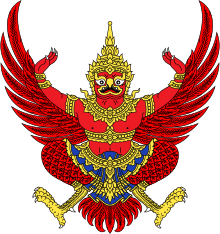Laos–Thailand relations
 |
|
Laos |
Thailand |
|---|---|
Laos–Thailand relations refers to the current and historical relationship between Laos and Thailand. Diplomatic relations were established in 1950.
Laos and Thailand share a common border and both states have an interest in making the Mekong River a "river of true peace and friendship"—as their respective prime ministers called for in 1976—also provides a north-south artery during the rainy season.[1]
History
An alarming patrol boat shooting incident occurred in 1980, but this brief encounter was overshadowed by the border disputes and military clashes of 1984 and 1987 in Xaignabouri Province west of the Mekong. These conflicts originated in rival claims to forest resources based on maps from the early days of the French protectorate.[1]
The determination in 1988 of Thai prime minister Chatichai Choonhavan to open up the Indochina market abruptly turned a deadly conflict into a wave of goodwill gestures and business ventures. Kaysone Phomvihan paid an official visit to Bangkok in 1989, his first since the brief 1979 rapprochement with Prime Minister General Kriangsak Chomanand. These gestures were followed by official visits by Princess Maha Chakkri in March 1990 and Crown Prince Maha Wachirolongkon in June 1992. An irony of this process of reacquaintance was the dropping from the Politburo in 1992 of Army Chief of Staff General Sisavath Keobounphanh, who had dealt closely and effectively with the Thai military command in restoring neighborly relations but who apparently was considered by his party colleagues to have indulged in personal gains. Indeed, this corruption of a senior party leader symbolizes the fear among some Laotian leaders that Thailand, with its materialism and business strength and greed, "want to eat us."[1]
Two political issues slowed rapprochement during the 1980s: first, the continuing issue of Laotian migrants and refugees remaining in temporary camps—whom Thailand had no desire to accept as immigrants—and second, Laotian and Hmong resistance groups who used the camps as a base. The Hmong constituted half of the camp dwellers and were expected to avoid repatriation the longest, out of fear of reprisal and hope for national autonomy. Thailand announced in July 1992, however, that Laotian refugees who have not returned home or found third-country resettlement by 1995 will be classified as illegal immigrants and face deportation.[1]
The persistence of a resistance movement since 1975 is attributable to permissive policies on the part of Thailand on behalf of their former Laotian cohorts. With the demise of the Cold War, the motivation to harass the LPDR and its Vietnamese military partners has dwindled. The Ministry of Foreign Affairs will continue to press the Thai military command to live up to its March 1991 agreement to disarm rebels and discourage Laotian sabotage operations. At the same time, Thailand has made clear its unwillingness to assimilate Hmong refugees.[1]
The threat of a return of Vietnamese troops remains as a cautionary note to the Thai military, who prefer to keep Laos as a buffer rather than the military line of contact with the Vietnamese. The Friendship Bridge should open the interior to more foreign trucking and commerce and more openly reveal any foreign military presence in Laos.[1]
In December 2009, Thai soldiers evicted more than 4,000 Hmong asylum seekers from a holding center and forcibly repatriated them to Laos.[2] This action was criticised by Human Rights Watch and the US State Department.[3]
Thai Government assistance
In 2012, the Thai Government agreed to provide loan assistance for two projects. The first loan of more than (718 million baht) will fund the construction of a 33 km road, that will be built from Phudu checkpoint in Thailand's Uttaradit province to Paklai district in Xayaboury province, Laos and second loan of more than 84 million Thai baht will be used for the second phase of development of Pakxe Airport in Champassak province.[4]
Lao Government assistance
In October 2011, Lao government presented 1.5 million baht to the Thai Government as a gesture of solidarity with the victims of the flooding.[5]
State visits
Thai Prime Minister Abhisit Vejjajiva visited Laos in December 2010 as part of the 60 year anniversiary of relations between the two countries. He stated that it was "Thai government’s policy to encourage the private sector and state enterprises to invest in Lao PDR, while enhancing corporate social responsibility, which renders benefits to local communities and protects the environment at the same time".[6]
On 31 May 2012, Lao Prime Minister Thongsing Thammavong visited his Thai counterpart Yingluck Shinawatra.[4]
References
- 1 2 3 4 5 6 Brown, MacAlister and Joseph J. Zasloff. "Relations with Thailand". Laos: a country study (Andrea Matles Savada, editor). Library of Congress Federal Research Division (July 1994). This article incorporates text from this source, which is in the public domain.
- ↑ "Thailand deports thousands of Hmong to Laos". BBC News. 2009-12-28. Retrieved 2016-10-22.
- ↑
- 1 2 "Laos, Thailand deepen cooperation" (PDF). Laoembassy.com. Retrieved 2016-10-22.
- ↑ "Lao govt assists Thai flood victims". Asiaone.com. 2011-10-17. Retrieved 2016-10-22.
- ↑

